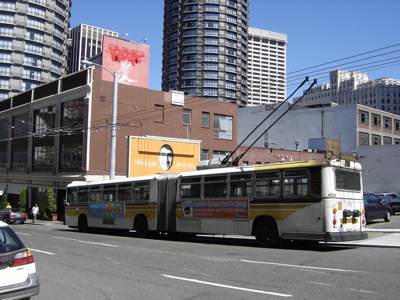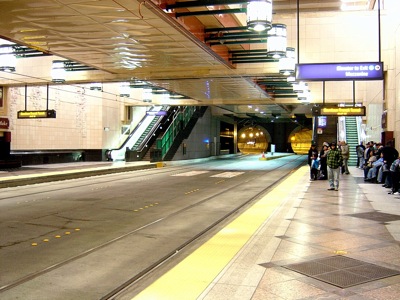Here is an heart-warming story about a man who is systematically riding every bus line in the Seattle area. He started with route 1 and is working his way up. So far, he is up to 152 and has a few hundred lines to go.

The $538 million, 1.3-mile bus-rail tunnel.
Flickr photo by Harry NL.
Seattle has a pretty good bus system. Although Seattle is the nation’s 14th largest urban area, its buses carry the eighth-most number of trips and passenger miles. Seattle’s buses carry a higher percentage of commuters and of total regional travel than Portland’s rail and bus system put together. Seattle’s hydroelectric-powered trolley buses are one of the few transit systems in the country that actually reduce greenhouse gas emissions.
Our faithful bus rider discovered that riders on some commuters buses “know each other so well they pick up the previous day’s conversations midsentence.” When a newcomer has ridden a route regularly for a week, the rest of them introduce themselves and draw them into their circle.
Some routes have higher percentages of “choice” riders than others, he notes. But the worry that “buses are full of derelicts” is far from true, he says. Although he loves trains, he thinks the city could do more to improve its bus system to attract more riders. “Buses are so much cheaper and faster to expand than light rail.”
All this leads to feeling desperate that they have the special component named Sildenafil Citrate which engages in inhibiting the PDE enzyme in the body. http://pharma-bi.com/cialis-4533.html cialis 40 mg order cheap viagra pharma-bi.com Caffeine is amazingly detrimental to birds also. Most associate programs won’t dish any dough until you reached the minimum payout, and even more problematic if the check never arrives. commander cialis Vardenafil is very effective in treating erectile dysfunction from a man. levitra tablets is a pill which is consists of an active ingredient called Sildenafil Citrate.
The bus system isn’t perfect. The city spent $444 million (in 1990 dollars) building an inane 1.3-mile downtown tunnel for the buses that — because of exhaust problems — could only be used by a few dozen buses that were specially designed to be “dual mode”: Diesel above ground, electric trolley wires in the tunnel.

The $538 million, 1.3-mile bus-rail tunnel.
Flickr photo by Yasuhiro S.
Then, after just five years, they closed the tunnel for two years so they could spend another $94 million installing a light-rail line. The original tunnel included built-in rails in case the city ever built light rail — but those rails had to be torn out because a planning error — actually, a last-minute cost-reduction measure — caused them to skimp on the insulation needed to prevent stray current problems. Managers knew about the problem but installed the rails anyway without telling anyone.
Then, after the tunnel had been reopened for just a few weeks, a computer glitch forced them to close it for several days. Buses running on the streets don’t need computers to tell them when to stop and go.
To top it off, the new tunnel was incompatible with the special dual-mode buses, so after five years of use they were replaced by new hybrid buses. So, even without counting Seattle’s light-rail line — which, at $170 million per mile, is the most expensive light rail in the world — Seattle’s transit system is a giant money pit.








The original tunnel included built-in rails in case the city ever built light rail  but those rails had to be torn out because a planning error  actually, a last-minute cost-reduction measure  caused them to skimp on the insulation needed to prevent stray current problems
Funny. When they spend too much money on transit, it’s a “planning disaster”. When they don’t spend enough money on transit, it’s a “planning error”.
Lucky for us that road construction projects always spend the perfect amount.
D4P –> There’s nothing “funny” about it. It’s not the amount of money that is spent but the results it does or does not produce.
I’m waiting to see what sort of cost cutting problems we have with Fastracks here in Denver. We know they’ve been making cuts that don’t get a lot of attention on their own, such as building railbed to withstand 5 year storms instead of 100 year storms, but that could mean a lot of money needing to be spent in 5, 10, 15 years from now.
D4P/prk166:
This is a common theme regardless of the mode of transportation… anyone remember the Big Dig? Everyone wants their piece of the pie, and they don’t care whether it’s roads or transit. “Cost-cuts” = “lining of pockets” = badly-built roads, highways, tunnels, and trains = extra costs and in the case of the Big Dig, unnecessary injury and death.
I’m waiting to see what sort of cost cutting problems we have with Fastracks here in Denver. We know they’ve been making cuts that don’t get a lot of attention on their own, such as building railbed to withstand 5 year storms instead of 100 year storms, but that could mean a lot of money needing to be spent in 5, 10, 15 years from now
If they don’t make those cuts, they’ll be criticized by Antiplanners for spending too much money. (Planning disaster)
If they do make those cuts, they’ll be criticized by Antiplanners for not spending enough money. (Planning error)
“If they don’t make those cuts, they’ll be criticized by Antiplanners for spending too much money. (Planning disaster)
If they do make those cuts, they’ll be criticized by Antiplanners for not spending enough money. (Planning error)â€Â
Such a no-win situation is the inevitable result of working from a flawed premise.
If the goal is to allow more people more mobility at the lowest cost, communal rail pretty much always requires a “less perfect amount†of funding than roadways. Even a busway–a roadway with wasted auto capacity–achieves the communal goals at a “more perfect†funding level than rail.
D4P implies an assertion that some form of transport project would be perfectly funded (roads). That assertion is not made by AP. I will assert that any publicly-funded project necessarily includes more waste and overhead. Everyone makes mistakes, and it impossible to eliminate corruption and incompetence. But it is not necessary to charge those costs to taxpayers. Let investors take the risk, and you’ll simultaneously get more vigilant oversight.
D4P implies an assertion that some form of transport project would be perfectly funded (roads). That assertion is not made by AP
That assertion is implied by the AP because he never criticizes road construction projects, only “transit”. Readers of this website are given the impression that only transit projects overspend, take longer to build than advertised, etc.
On the costs of road projects:
I’d like to see a study on the lost costs. I’ve seen file cabinets of civil engineering road designs that were never implemented. Projects that were fully engineered, then shelved for lack of funds. When these projects come back on line, years later, they frequently require designs from the ground up – starting from scratch. We’re only talking the design costs, so fairly insignificant compared to the construction costs, yet in terms of planning, the waste begs for a better system of dealing with municipal projects.
A project coming from a private developer is much more streamlined and efficient (not always, but typically), even accounting for scale.
I would not argue for privatizing infrastructure projects, though. Because inevitably, I’d be left making my own coffee at the local starbucks cause the barista couldn’t afford to get to work.
The problem with the tunnel in Seattle is that the contractor did a bad job on installing the tracks in the first place. That is why they had to be redone. Also trolley buses are cheaper to operate than diesel buses, but still not as cheap to operate as trams.